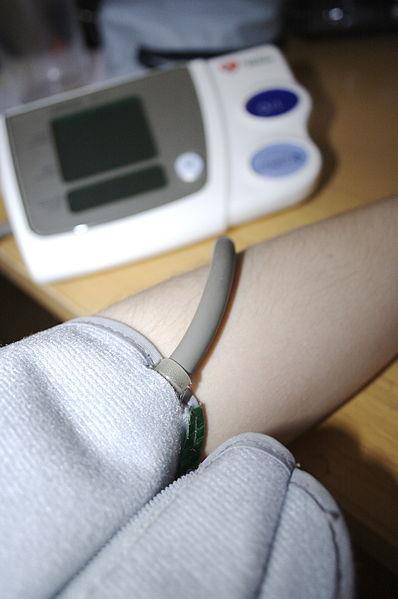Joseph R. Anticaglia MD
Medical Advisory Board
There is a definite need for better control of high blood pressure in the United States. According to the American Heart Association (AHA), “roughly 39 million Americans are at risk for serious health issues due to uncontrolled high blood pressure,” which includes an increased risk of stroke, heart attack, heart failure, vision loss and kidney disease.
The AHA and other organization estimate that up to one in three individuals with elevated blood pressures in an office setting may have normal blood pressures when measured outside of the office (‘White-Coat’ Hypertension). To counteract these false positive BP readings, taking your blood pressure at home minimizes such miscalculations.
As noted in an earlier post, “There are two numbers used to measure blood pressure. The first number, systolic blood pressure represents the health of the heart muscle’s ability to contract and pump blood away from the heart (cardiac output) through the arteries and into the tiny capillaries.
The second number, diastolic blood pressure represents the health of the arteries. It measures the pressure, namely, the resistance to the flow of blood in the arteries when the heart is between beats and relaxes.
Normal blood pressure is 120 systolic (upper number) and 80 diastolic (lower number) written as a fraction — 120/80.” The American Heart Association and other organizations offer guidelines concerning home blood pressure monitoring (HBPM).

“Tips” — Home Blood Pressure Monitoring
- Ask your doctor to recommend an automatic home blood pressure device, an upper arm model with an inflatable cuff. (Bring the device to your doctor’s office to check its accuracy against the office’s model.)
- Make sure the cuff is the right size for you. (A cuff that’s too tight or too loose can give inaccurate BP readings. The blood pressure readings should be clear and easy to read.)
- When first using the device, take the readings from both arms to document there’s not a big difference between the measurements of each arm. (A reading of 10 mmHg or less between the right and left arm is of no concern.)
- Measure your BP twice daily at the same times. In the morning — after you’ve emptied your bladder and before eating, taking medications, smoking, or drinking caffeinated beverages — and in the evening before dinner. Don’t take it after you have recently exercised (within thirty minutes of the exercise),
- Sit quietly and comfortable in a chair for about five minutes with uncrossed legs. Support your arm, for instance, on a table so that the upper arm is at the level of your heart. Try not to be distracted when taking your B. P.
- Take measurements on bare skin not over clothes. Place the button of the cuff above the bend of the elbow. Place it on the medial side of the elbow, the side closest to the body and just above the bend of the elbow,
- Take two or three readings of your blood pressure, one or two minutes apart to check its accuracy
- Record BP measurements
- After a few days of recording your BP, you might read once again the information that came with the blood pressure device and add your own tips.
Blood Pressure Readings
High blood pressure (hypertension) happens when the force of the blood pushing against the walls of your arteries is consistently too high.
Normal
Systolic 120 mmHg (or less than 120)
Diastolic 80 mmHg (or less than 80)
Prehypertension
Systolic: 120 — 139 mmHg
Diastolic: 80 — 89 mmHg
Hypertension Stage 1
Systolic 140 — 159 mmHg
Diastolic: 90 — 99 mmHg
Hypertension Stage 2
Systolic: 160 mmHg or higher
Diastolic: 100 mmHg or higher
Hypertensive Crisis (Emergency care needed)
Systolic: Higher than 180 mmHg
Diastolic Higher than 110 mmHg
If your blood pressure is HIGH:
Persistent, uncontrolled hypertension can lead to heart attacks, stroke or heart failure. It can damage the kidneys and cause vision problems. High blood pressure also puts you at risk to develop hardening of the arteries and sexual dysfunction.
The AHA advises that a single high reading is no cause for alarm. If your B. P suddenly goes above 180/120 mmHg, wait five minutes and test again. If the reading remains high, contact your doctor immediately. If your blood pressure is above 180/120 mmHg and you’re having chest pain, shortness of breath, back pain, trouble with vision or speaking, call 911.
Benefits
Monitoring your BP at home can make you more responsible for your health, make you aware as to whether the medications are working or not and might cut down on your doctor’s visits and save you money. It is worth the time to discuss with your physician, whether or not you can benefit from home blood pressure monitoring.
References
- Paul Muntner, Chair Daichi Shimbo et al; Measurement of Blood Pressure in Humans; American Heart Association, March 2019
- Jacob George and Thomas MacDonald; Home Blood Pressure Monitoring; Eur Cardiol. Dec 2015
- John M Eisenberg Center for Clinical Decisions and Communications Science; Measuring Your Blood Pressure at Home; February 22, 2012
- Joseph R. Anticaglia, MD; Hypertension, The Silent Killer; HC Smart, October 2018
This article is intended solely as a learning experience. Please consult your physician for diagnostic and treatment options.

